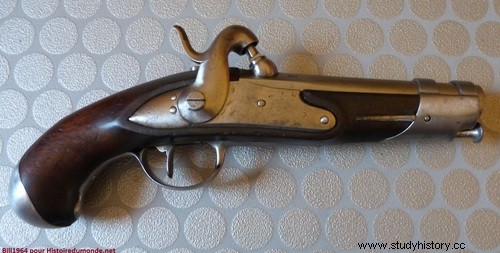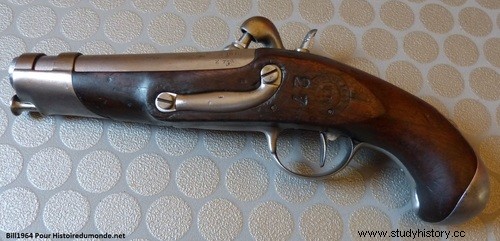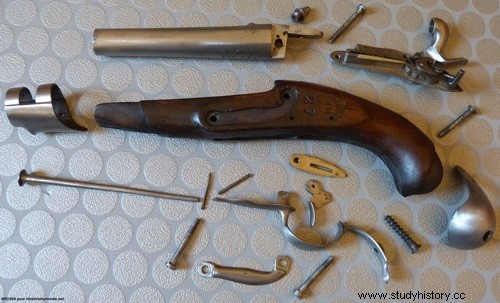
FROM PISTOL D'ARÇON TO HALF-ARÇON
It is the ordinance of 1769, concerning the Maréchaussées, which very precisely gives the origin of this new model of handgun unusual until then; thus creating an armament specific to the gendarmerie which previously was equipped like the rest of the cavalry.
The text specifies:“the riders will be armed with a carabiner and a bayonet; of a pair of pistols only nine inches in length, so that they can serve them at the same time as pocket pistols… »
Further on it is mentioned the leather castings (red) of the length and proportion of the pistols, therefore these small pistols must be used indisputably as well on horseback as on foot; which is logical, because the large pommel pistols of the model 1733 used previously had to embarrass the men when the service required them to dismount, fact much more frequent for the gendarmerie than for the other weapons, because it enforces the "Force à la Loi".
These small pistols, logically called half-tree pistols, can therefore be easily placed in the pockets of the coat; their reduced size compared to pommel pistols, also lends itself better to close defense.
The Royal Factory of Charleville was responsible for the design and manufacture of this new model of pistol, the 1770 model.
To complete the provisions of 1769, the ordinance of 1778 also provides for a small cartridge pouch with six holes, attached to the cast of the right pistol for service on horseback and comprising a strap attached to two buttons specially placed on the jacket, for service on foot.

THE AN IX MODEL GENDARMERIE PISTOLS:
Apart from a slightly stronger lock and mount, this model of pistol is only the “renewal” of the previous model from 1770.
This weapon will be manufactured exclusively by the Maubeuge factory.
The production will be "considerable" reaching a total of 32,000 pairs between the year X (September 23, 1801 to September 22, 1802) and the year 1819 which marks the end of production with 1 970 pairs of pistols.
TRANSFORMED GUNS:
The adoption of percussion firing made large quantities of weapons obsolete, most of the time in excellent condition.
In 1841, Captain Arcelin perfected the transformation that was to be performed on both handguns and long guns.
(For the record:first, the light is plugged with a steel grit, the new light being an integral part of a counterweight screwed (sometimes brazed) on the barrel and tapped in order to receive the funnel. On the plate a screwed part is fitted, filling the old notch of the basin. The hammer is replaced by another hammer for capsule. The tails breech retain the model year IX, 1816 or model 1822 indication, followed by a T placed behind the breech screw.)
On gendarmerie pistols the hammer is slightly different from that of other weapons transformed, in order to allow cocking with one hand, with the thumb. The chimneys used are also different since they are of the civil type, also called the "hunting" or commercial type.

Unlike other weapons, converted police pistols never received rise and were never scratched; there is no Tbis transformation for these models.
The transformations were carried out on almost all the 1816-1822 models and on the An IX models whose condition was good enough to that they are still in service.
Based on a production of 64,000 copies of the An IX model, it can be argued that without being particularly rare, the An IX T model is not not the most common either; the last examples produced in 1819 having already been in service for more than twenty years during their transformation, they still had to be in good enough condition to justify their continued service.
